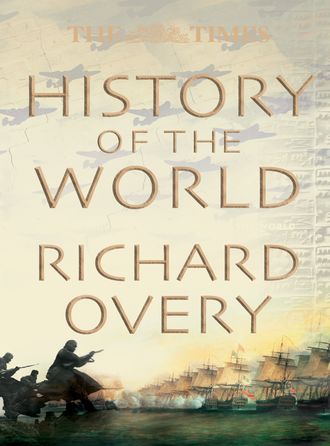
Полная версия
The Times History of the World
THE PUNIC WARS
By 264 BC Rome controlled the whole of the Italian peninsula and had emerged as a powerful confederacy and the principal rival to the other major power in the western Mediterranean, Carthage. The Romans were forced to develop naval skills to defeat Carthage in the First Punic War (264–241 BC), in which Rome drove the Carthaginians out of Sicily; soon after Corsica and Sardinia were seized as well. In the Second Punic War (218–201 BC), Rome was invaded from the north, when Hannibal brought his army and elephants from Spain over the Alps into Italy. Though Rome suffered devastating defeats at Lake Trasimene (217 BC) and Cannae (216 BC) it was able to draw on great reserves of Italian manpower to drive Hannibal out of Italy and defeat him at Zama in north Africa (202 BC). With Spain added to Rome’s provinces, the city now commanded the whole of the western and central Mediterranean.
EXPANSION TO THE EAST
In the following 50 years, Roman commanders turned their attention eastwards, leading expeditions into Greece, but withdrawing their troops once victory was assured, in part from fear that Italy, always most vulnerable to attack from the north, would be invaded. Nonetheless, in 146 BC Macedonia was added to the empire, with the province of Asia following in 133 BC.
Among the consequences of Roman victories abroad was an influx of goods and people into Italy. Works of art were taken from Greek temples to adorn private Roman villas, while Greek literature, rhetoric and philosophy had a profound effect on the nature of Roman politics. Wars also provided cheap slaves, who were brought to Italy as agricultural labourers, threatening the livelihoods of Italian peasant farmers and leading to the rapid growth of the urban population of Rome itself.
FROM REPUBLIC TO EMPIRE
The period from 133 BC saw increasing turbulence within Rome and Italy. Rome’s continuing expansion provided opportunities for ambitious men to use their military commands to dominate Roman politics, and the institutions of the republic were powerless to regulate the competition between them. Slave revolts and the Social War with Rome’s Italian allies (91–89 BC) increased disorder within Italy. The last generation of the republic saw the system collapse in a series of civil wars which ended only in 31 BC when Octavian emerged triumphant at the battle of Actium and found himself in a position of such dominance that he was able to rebuild the government of Rome and make it capable of administering an empire.
31 BC TO AD 235
THE HEIGHT OF ROMAN POWER
Augustus, the first emperor, transformed the government of the Roman empire. He brought an end to internal conflicts and created a standing army to guard the empire’s frontiers and extend its power. As Roman culture and organization spread throughout the empire, it laid the foundations for the development of the Mediterranean world.
In 31 BC Octavian, the future emperor Augustus, was undisputed master of Rome. His popularity as adopted son of Julius Caesar and victor over Cleopatra and Mark Antony at the battle of Actium allowed him to rebuild the shattered Roman republic into a system of government capable of controlling a vast empire, reforms which were to bring Rome a new and intense surge of life and two and a half centuries of almost uninterrupted peace and prosperity.
Augustus’s reforms were far-reaching. He restored the prestige of the Senate, though not, in practice, its influence. He reorganized the army and, in 27 BC, took command of those parts of the empire where legions were stationed. From then on responsibility for the defence of the empire lay with the emperor alone. At the same time he took the religiously significant name Augustus, and stressed his relationship to the now deified Julius Caesar. Among his many priesthoods was that of Pontifex Maximus, chief priest, and from the time of Augustus onward the emperor became the focus of all Roman religious ritual.
In 19 BC Augustus was given the power to rule by decree, and although he continued to pay due respect to the Senate, whose members he needed to command the legions and to administer the provinces, his authority was now absolute. The vast wealth he had inherited and won (his defeat of Antony and Cleopatra left Egypt as his personal domain) was further increased by bequests from the rich throughout the empire. At his death his property was worth thousands of times as much as that of even the richest senator. That his heir should also inherit his position as head of the empire was inevitable.
In the event, Augustus had great difficulty in finding an heir, eventually settling on his stepson Tiberius (AD 14–37), who had been a successful military commander but took on the role of emperor with reluctance. Neither he nor his successors were able to maintain good relations with the Senate, and the failure of Nero (54–68) to prevent revolt in the provinces led to his enforced suicide and the end of the Julio-Claudian dynasty. After a year of civil war, Vespasian (69–79) restored order. He was succeeded by his sons, Titus (79–81) and Domitian (81–96). Though the latter was generally regarded as a cruel and probably insane tyrant, many of his imperial policies were adopted by his successors, especially Trajan (98–117), who began the practice of appearing before the Senate not in a toga but in the purple cloak and armour of a triumphant general. This was to become the uniform of the emperor for the next thousand years.
STABILITY AND STRIFE
Domitian’s assassination was followed by nearly a century of stability as emperors without sons of their own chose their successors from the Senate. Civil war returned in 193, from which Septimius Severus (193–211) emerged victorious. He ruled with his sons Caracalla (198–217) and Geta (209–12), setting a pattern that was to be followed in the following centuries. Caracalla was murdered, and after him came a series of short-lived emperors, of whom Severus Alexander (222–35) was the last who could claim a dynastic link to his predecessors.
THE NATURE OF ROME
The emperor’s figure was central to the empire: everywhere statues and coins were constant reminders of his presence. In the former Hellenistic kingdoms the kings had been the objects of religious worship, a practice which continued with the cult of the emperors. In the western provinces, temples and altars dedicated to the emperor became focuses of Romanization.
The early 2nd century saw important cultural developments: Greek and Latin literature flourished; and the distinction between Italy and the provinces dissolved as rich men from all over the empire were admitted to the Senate, with some, such as Trajan and Hadrian (117–38), even becoming emperor. For the poor there were fewer benefits, and differences in the rights and privileges of rich and poor grew. By the time Caracalla extended Roman citizenship throughout the empire in AD 212, it gave little advantage to the newly enfranchised citizens. Later in the 2nd century, pressures grew on the frontiers. Marcus Aurelius (161–80) spent much of his reign at war with barbarian invaders, and his successors faced threats both from the north, and, after 224, from the rejuvenated Persian empire under the Sasanids.
AD 235 TO 565
FROM ROME TO BYZANTIUM
The 4th century AD saw Roman emperors still ruling an empire that stretched from Spain to Syria. In the 5th century the two halves of the empire experienced different fortunes. Roman administration in the west dissolved in the face of increasing barbarian settlement, but in the east Byzantine civilization, combining Greek and Roman practices and culture, grew and flourished.
The empire emerged from the storms of the 3rd century intact but not unchanged. Diocletian and his successors owed their position to the army, not the Senate, and the military now provided most of the provincial governors. Rome itself ceased to be the centre of empire, as the emperors based themselves in cities nearer the frontiers: Mediolanum (Milan) in Italy; and, after AD 330, Constantinople in the east. The emperors were surrounded by large courts, increasingly turning to eunuchs as their closest advisors. To maintain the army, the taxation system was reformed and military service became a hereditary obligation. But as the senators in Italy and other rich landowners were increasingly excluded from power, so they became less inclined to support the emperor, a development which was to have a profound effect on the western half of the empire.
THE RISE OF CHRISTIANITY
But the greatest change to the empire was religious. In 312 Constantine defeated his rival Maxentius outside Rome, and he came to attribute his victory to the support of the Christian god. In his reign and that of his son Constantius II the churches received many favours from the emperor, and Christianity began to establish itself as the dominant religion of the empire. The last pagan emperor, Julian, died in AD 363 on campaign against the Persians before he had the opportunity to reverse the trend. Bishops such as St Ambrose in Milan (374–97) became increasingly powerful figures in the empire.
Barbarian incursions continued to erode central control of the empire. The arrival of the Huns in eastern Europe in 376 drove many Goths across the Danube, forcing them into Roman territory. Having in 378 defeated the Romans at Adrianople, in 405 they invaded Italy. In the winter of 406 German tribes then crossed the frozen river Rhine in unstoppable masses. The situation deteriorated throughout the century. The Vandals marched through Gaul and Spain before crossing to Africa where they captured Carthage, the chief city, in 439 and set up their own kingdom.
Where in the 4th century the Roman army had made use of barbarian officers, now the western emperors had little choice but to make grants of land for the invaders to settle on and to employ them in the army. With landowners unwilling to allow their tenants to fight, what had been a Roman citizen army became a barbarian mercenary one. Since the frontiers were no longer preventing barbarians from entering the western empire, and since the army was itself largely barbarian, the role of the emperor in the west was effectively redundant.
In 476 the magister militum (the chief military officer of the western empire) Odoacer, a German, deposed the emperor Romulus Augustulus, and did not replace him. With the eastern emperor making no attempt to resist this, the western empire ceased to exist. In 490 the Ostrogoths took control of Italy, and by 507 the Franks had established an extensive kingdom in Gaul (see p. 94). Yet Roman institutions survived: the Roman Senate continued to sit, and Latin remained the language of government.
THE RECONQUESTS OF JUSTINIAN
The eastern part of the empire possessed greater resources than the west, and eastern emperors could use their wealth to persuade would-be invaders to move away westwards. Although Roman culture continued to flourish in the eastern part of the empire, there were growing cultural differences between east and west: when Justinian launched his attempt to reconquer the former western empire, he was trying to impose a Greek-speaking administration on Latinspeaking territories.
Justinian’s reign was a mixture of triumph and disaster. In Constantinople it saw the building of the great church of St Sophia (532–63) as well as a devastating plague in 542. His general Belisarius took Africa from the Vandals in 533–4 while in 554, after a campaign lasting 20 years, Ostrogothic rule in Italy was ended. But Justinian’s successes in Italy were short-lived: the Lombard invasion of 568 left only Ravenna in Byzantine hands. Meanwhile in the east there was war with Persia (540–62): Antioch was sacked in 540 and peace was eventually bought only at great financial cost. Justinian’s wars left Byzantium seriously weakened. The dream of a reunited empire died with him.
TO AD 600
THE RISE OF CHRISTIANITY
Christianity began as a small sect within Judaism, but gradually established itself as a significant religious and intellectual force throughout the Roman empire. It offered both a promise of eternal salvation to individuals and, from the 4th century onwards, a powerful new vision of an empire united under a Christian ruler which was to be of enormous significance for the future of Europe.
The earliest Christians did not see themselves as founders of a new religion but as witnesses to the fulfilment of God’s promise to provide his people, the Jews, with a Messiah or redeemer. By raising him from the dead, they believed that God had shown that Jesus of Nazareth was this Messiah and that the risen Jesus had commissioned his disciples to preach the good news of God’s kingdom.
Конец ознакомительного фрагмента.
Текст предоставлен ООО «ЛитРес».
Прочитайте эту книгу целиком, купив полную легальную версию на ЛитРес.
Безопасно оплатить книгу можно банковской картой Visa, MasterCard, Maestro, со счета мобильного телефона, с платежного терминала, в салоне МТС или Связной, через PayPal, WebMoney, Яндекс.Деньги, QIWI Кошелек, бонусными картами или другим удобным Вам способом.




